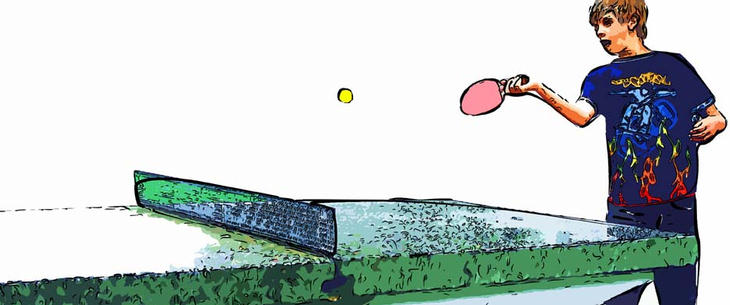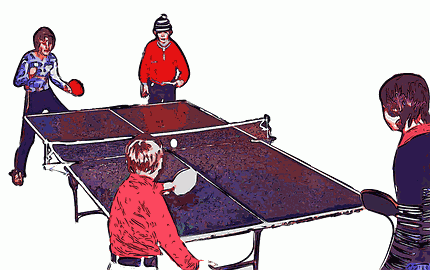source: www.youthwork-practice.com | 2000 Games, Devotions, Themes, Ideas and more for Youth Work
only for private using
Table tennis: Table tennis with one or more table tennis tables
Table tennis is a popular game for children and adolescents alike. The advantage of table tennis is that it can be implemented very quickly, can serve as a time filler, or even as a tournament. Table tennis is one of the classic revers games such as tennis or badminton. Reflex and skill, coordination, sophistication, fine motor skills, tactics, feint, concentration, self-control and stamina, all come together while playing table tennis. It is equally possible for the elderly playing against the young or for boys to play against girls. This makes table tennis a co-educational game par excellence.
If one side of the table is folded up, table tennis can easily be player by one player on his own.
Otherwise, the classic single game (2 people play against each other), as a double (2 play together on each one side of the table), with even more people, called Mäxxle or in any other variable of the game.

Games around table tennis tables
©: www.youthwork-practice.com
The various options are spontaneous and quick to implement, provide distractions in the group program, or if you had to change plans, due to rain, it quickly becomes a replacement program for the youth group.
In the following, different ways of the game are listed:
Games with one table tennis table

Classic double table tennis
©: www.youthwork-practice.com
-
Classic single match
-
Classic double
-
Mäxxle: each half of the players are on one side of the table tennis table. One player starts and plays the tennis ball on the obliquely opposite field. Immediately, the player switches sides and turns to the rear. The player (from the opposite field) tries to play the ball back to the now foremost player. He, who makes a mistake will be eliminated. The last 2 players play against each other (until a difference of 2 points exist). The winner will receive 2 points and the loser one point. The objective is to collect as much as possible points by the end of each rounds.
-
The respective table halves are placed within 1 meter of each other
Two table tennis tables
-
On each side there are 3 persons; the ball is played to opposite player, this player plays the ball back to the middle man (opposite). This one plays to the central player who will in turn play to the left player (opposite), which then also plays to his direct opposite player.
-
12 players are gathered around the two table tennis tables. 4 + 4 players at the long side (the side which divided by the net) and 2 players each on the small side of the table.
Thus, there are 6 couples, who each play the ball to each other. All 6 balls are not allowed touch one another. This is a super coordination game.
-
A combination to the 1st match. One ball must be played in a zigzag cross game. This is a game without winner or loser but a game about skill and teamwork.
More table tennis tables
-
3 or more tables are all parallel to each other. At each table players are facing one another. One side will start and plays to the other side. Immediately, the player who just played the ball runs to the next table, while the opposite person plays the ball back to the next incoming player, who takes the ball and plays it back.
-
3 table halves face each other at a 60 degree angle. One tennis ball is played alternately in the triangle.
-
3 table halves are stacked behind each other. There are 2 available nets. The ball must hit the table 2x (which is one more time than usually), before it can be played back.
[ © www.youthwork-practice.com | 2000 Games and Ideas for Youth Work ]






